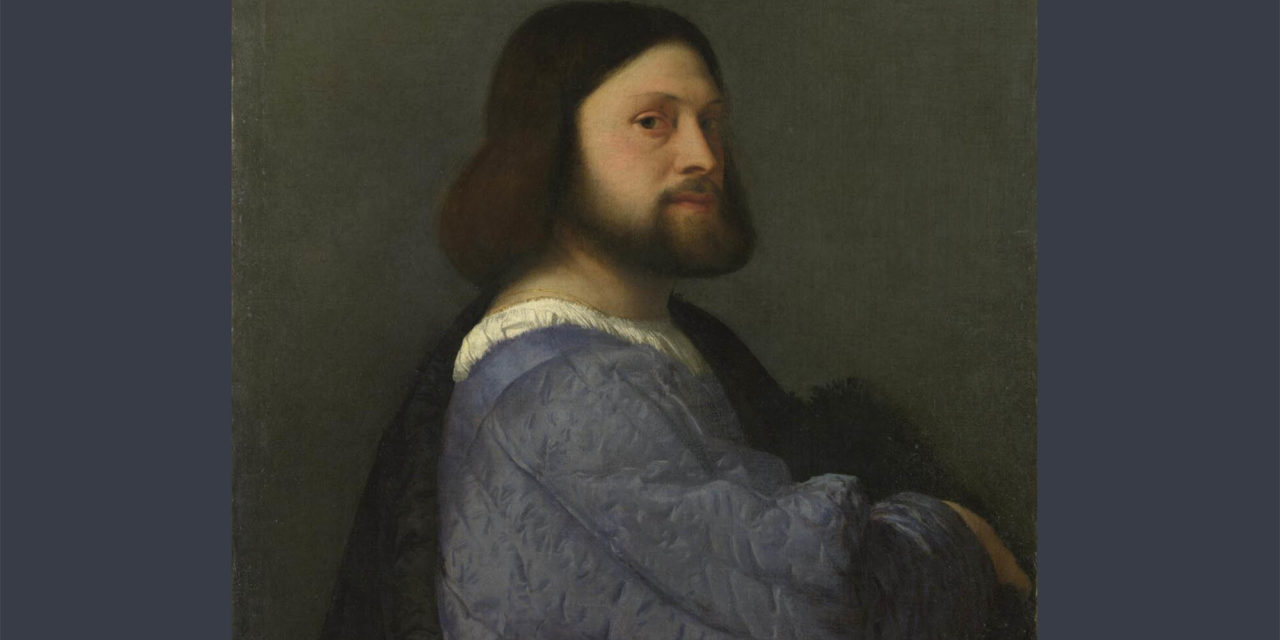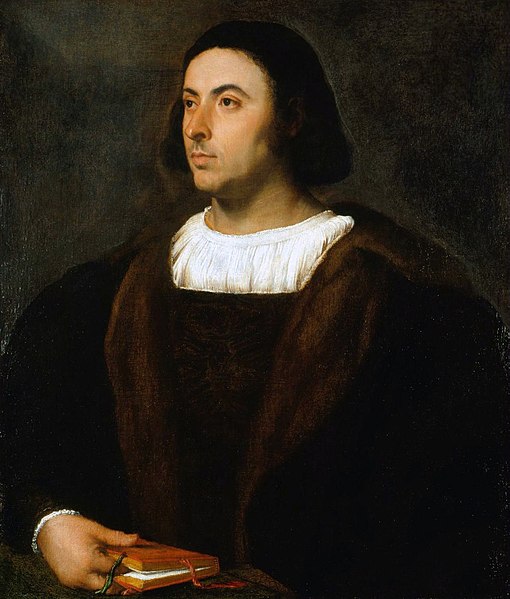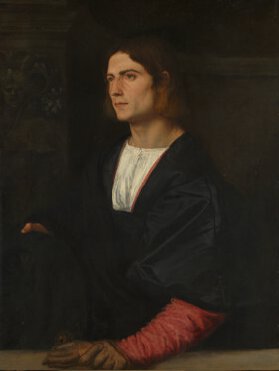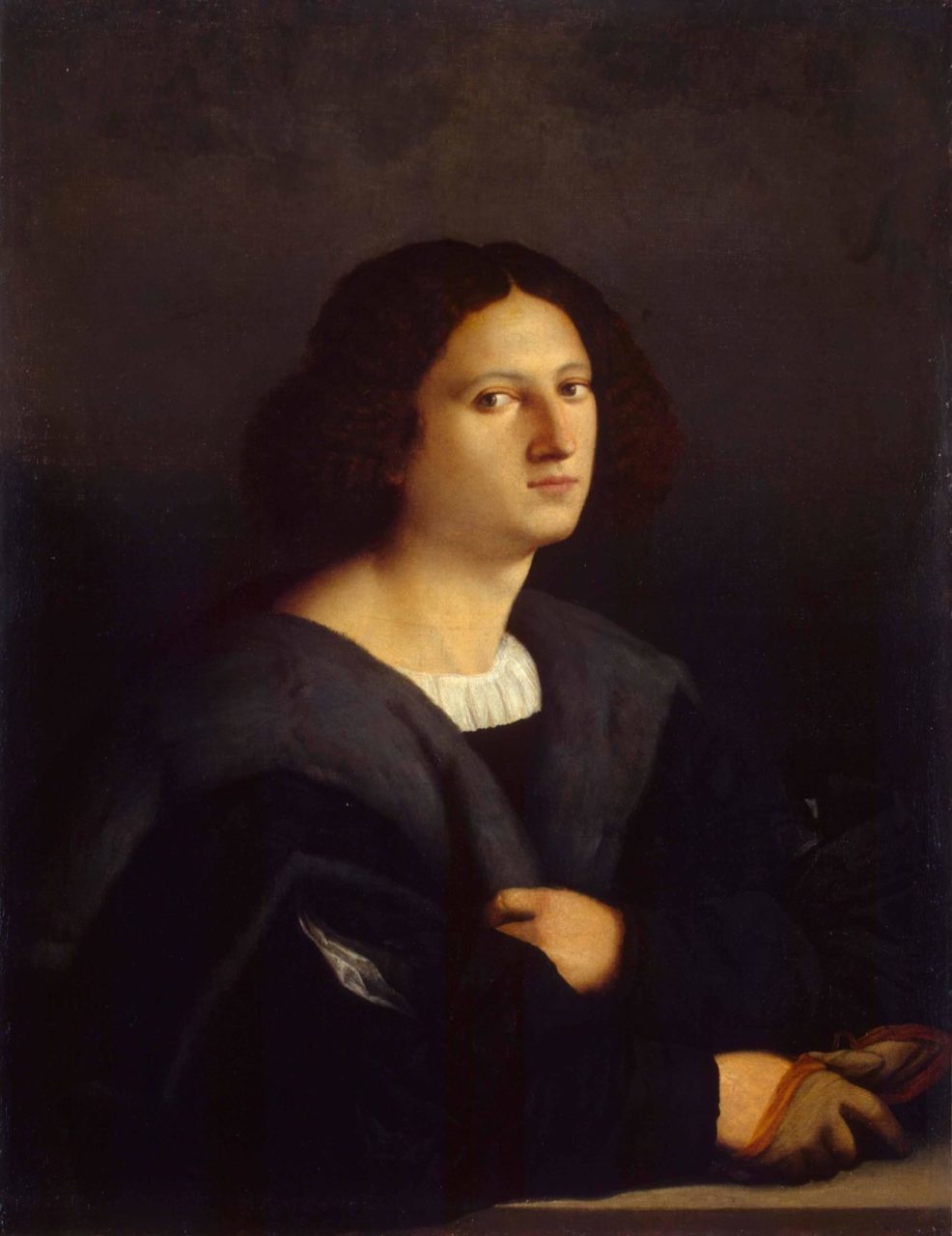Titian’s portrait of Gerolamo Barbarigo from the beginning of the 16th century captures the young Venetian looking his fashionable best, lavishly dressed for his decade.
About the Portrait
T
itian’s A Man With a Quilted Sleeve (also known as A Man With a Blue Sleeve) is well-known and often-praised, and yet nobody is sure who the sitter is. Some have postulated it to be Ludovico Ariosto, a contemporary Italian poet, and others have guessed it to be a self-portrait (Krén). Only in recent years have art historians settled on the figure being Gerolamo Barbarigo, a member of an aristocratic Venetian family (NG).
Titian, born Tiziano Vecellio, was a Venetian painter who lived c. 1488-90 through 1576, dying at the age of 88. Born in Pieve Di Cadore, Titian was sent at a young age to study with the Bellini brothers – most notably Giovanni – in nearby Venice (Gould). Titian was quickly recognized for his incredible skill and particular use of paint and color, and was soon sought after by patrons in Venice and beyond. His innovations became a major influence on Renaissance painting as well as later works in Western art.
This portrait of Gerolamo Barbarigo, or The Man with a Quilted Sleeve, is one of Titian’s earliest recorded works and was painted c. 1509-1510. Of the sitter, little is known other than that he belonged to the Barbarigos, an influential Venetian family.
Other portraits done by Titian around this time are Portrait of Jacopo Sannazaro (Fig. 1) and Portrait of a Young Man (Fig. 2). These paintings, as well as several others below, were all painted within a decade or so and will allow us to see not only the emerging Renaissance style of portrait painting, but more importantly the beginning of 16th-century men’s fashion.
Fig. 1 - Titian (Italian, 1488-1576). Portrait of Jacopo Sannazaro, 1514-18. Oil on canvas; 85.7 x 72.7 cm. London: Buckingham Palace, RCIN 407190. Source: Royal Collection Trust
Fig. 2 - Titian (Italian, 1488-1576). Portrait of a Young Man, 1515-1520. Oil on canvas; 92.7 x 70.7 cm. London: National Gallery London, L611. On loan from the Earl of Halifax. Source: The National Gallery of London
Titian (Venetian, 1488-1576). Portrait of Gerolamo Barbarigo, about 1510. Oil on canvas; 81.2 x 66.3 cm. London: The National Gallery of London, NG1944. Source: The National Gallery of London
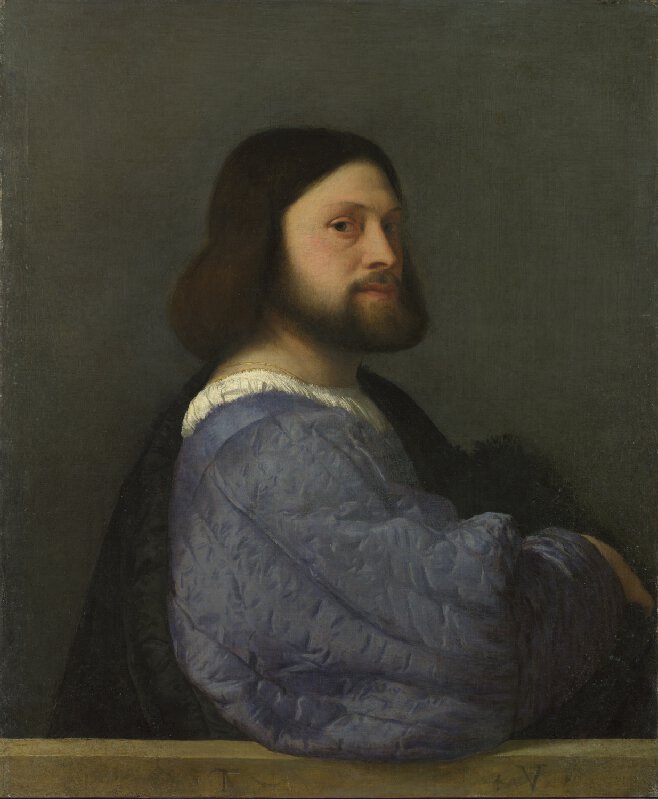
About the Fashion
Let’s start with Gerolamo’s outermost layer and work our way in. Kelly and Schwabe, discussing late 15th and early 16th century fashion, write about “the cloak being considered as simply draped or slung from the shoulder…often lined or faced with fur or rich materials,” and donned as “apparently mere drapery wrapped about at the will of the wearer” (2, 7). Looking at Gerolamo, we can see much of that holds true. The cloak, dyed expensive black, is of some fine and lustrous material, possibly silk or wool. However, upon closer look, you may notice a fluffy shape in the background of the portrait – making this cloak likely edged or lined with fur, as the gown in figure 1 is. He wears it loosely draped over one shoulder, seemingly devoid of hardware or fasteners, which would fit this decade’s style as described above. If the fur is only an additional decoration and not the whole fabric, the texture seen on the cloak could be a decorative weave, but based on the popularity of slashing during this time it is more likely just that.
Moving on to his blue doublet, we refer back to Kelly and Schwabe in reference to the two decades from 1490-1510: “There are many examples of sleeves slashed… and puffed at the shoulder and elbow, or paned (slashed into longitudinal bands or panels) above the elbow” (6). However, Titian’s gentle style combined with the low lighting of the painting makes it difficult to distinguish whether this is more typical slashing or if it is possibly quilting instead. (Little has been written about the use of quilting during this time). The sleeves appear to be constructed in a paned style, but with the gaps closed up in long seams. In general, there is usually a contrasting color which appears underneath slashing and open paning, but here all we see is the creamy blue of the outside of Gerolamo’s doublet.
Another key element to note is the sleeve size. On 16th-century sleeve size, Tortora and Eubank write: “Often they had a full, wide puff at the top, and were more closely fitted from above the elbow to the wrist” and were made in two pieces, which appears to be the case in this portrait given the slight seam just below his elbow (193). Later in the century, “one-piece sleeves were full at the shoulder and tapered gradually to the wrist,” as those in figure 4 do (188).
The cut of the garment is certainly up to fashionable standard; Tortora notes that “the necklines tended to be lower, some more square than round” and “at the front, the garments appear to have a collarless neckline. At the center of the back a deep U-shaped piece was cut out” (190, 187). Both these comments prove true with Gerolamo’s doublet, which is similar to the cut of the doublets in figures 4 & 5.
Finally, we have the camicia, or shirt. We know they were constructed of linen; “shirts were made of coarse, heavy linen for lower-class men and finer, softer linen for upper-class men” (Tortora 187). Its creamy white color means that it was bleached, a process that took many days of sunlight and processing (Dolan 171). Tortora also tells us that “camicie…” (plural of camicia) “…were often embroidered or otherwise decorated, and sometimes finished with a small neckline ruffle” (193). Upon close inspection, Gerolamo’s camicia edge contains both small ruffles from the fine stroked gathering and some gold embroidery. The gathers may be easier to see on figure 3.
Another style element of this time period to note is his hairstyle. Just as one author describes:
“What is clear is that the hair-cut of the 1490s with its straight fringe across the forehead…was abandoned in the early years of the sixteenth century in favor of a smooth bare forehead and hair parted invariably in the centre.” (Newton 42)
Each sitter (Figs. 1-5) has long hair with a center part in the same style. While only some have beards, clearly Gerolamo is up to date with fashion. If we assume that the rest of his style is as fashionable as this, we can extrapolate concerning his remaining clothing, invisible beyond the bounds of the portrait. He may be wearing wearing a short skirted gown of the same color as the doublet. He certainly has a pair of tight hose, which are laced (attached) to his doublet at the waist. He has likely forsaken poulaines – the long, narrow shoe of past decades – for the fashionable wide-toed ‘duck-bill’ or ‘cow-mouth’ shoes. Also to note is the gold chain around his neck and his full beard, both of which were popular during this time.
Judging by the quality of his garments – the fine cloak with fur, the silk doublet, and the fine linen camicia – we know Gerolamo is no peasant. Even if we had not known that he came from a wealthy Venetian family, his status is clearly apparent from his clothing. Though they are of the same cut as his everyday clothes, he certainly dressed in his best garments for the portrait. From everything we have discussed, it is obvious that Gerolamo Barbarigo – if that is who this is – was a highly fashionable figure in his time.
Fig. 3 - Titian (Italian, 1488-1576). Portrait of a Man, 1515. Oil on canvas; (50.2 x 45.1 cm) (19 3/4 x 17 3/4 in). New York: The Metropolitan Museum of Art, 14.40.640. Bequest of Benjamin Altman, 1913. Source: MMA
Fig. 4 - Palma Vecchio (Italian, 1480-1528). Portrait of a Man, 1512-1515. Oil on canvas; 93.5 x 72 cm. St. Petersburg, Russia: Hermitage Museum, ГЭ-258. Entered the Hermitage in 1886; formerly in the A.M. Golitsyn collection (the Golitsyn Museum in Moscow). Source: Hermitage Museum
Fig. 5 - Titian (Italian, 1488-1576). Portrait of a Man, 1508-1510. Oil on canvas; (23.5 x 18.5 in). Indianapolis: Indianapolis Museum of Art, 47.1. Gift in memory of Booth Tarkington. Source: IMA
Diagram of referenced dress features.
Source: Author
References:
- Dolan, Alice. “The Fabric of Life: Linen and Life Cycle in England, 1678-1810.” PhD Thesis, University of Hertfordshire. June 2015. Link
- Gould, Cecil. “Titian.” Grove Art Online. 2003; Accessed 26 Nov. 2019. https://libproxy.fitsuny.edu:3117/groveart/view/10.1093/gao/9781884446054.001.0001/oao-9781884446054-e-7000085242.
- Kelly, Francis Michael, and Randolph Schwabe. European Costume and Fashion, 1490-1790. 2nd ed. Dover Pictorial Archive Series. Mineola, NY: Dover Publications, 2002. http://www.worldcat.org/oclc/962876571.
- Krén, Emil, and Daniel Marx. “Man with the Blue Sleeve.” Web Gallery of Art. https://www.wga.hu/html_m/t/tiziano/10/21/01bluesl.html
- “Titian | Portrait of Gerolamo (?) Barbarigo | NG1944 | National Gallery, London.” Accessed November 26, 2019. https://www.nationalgallery.org.uk/paintings/titian-portrait-of-gerolamo-barbarigo.
- Tortora, Phyllis G., and Keith Eubank. Survey of Historic Costume: A History of Western Dress. 5th ed. New York, NY: Fairchild Publications, 2010. http://www.worldcat.org/oclc/1066139148.

